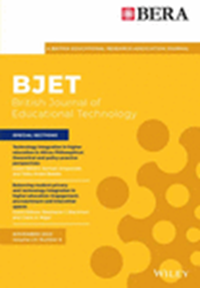Hybrid teaching intelligence: Lessons learned from an embodied mathematics learning experience
Abstract
As AI increasingly enters classrooms, educational designers have begun investigating students' learning processes vis-à-vis simultaneous feedback from active sources—AI and the teacher. Nevertheless, there is a need to delve into a more comprehensive understanding of the orchestration of interactions between teachers and AI systems in educational settings. The research objective of this paper is to identify the challenges and opportunities when AI intertwines with instruction and examine how this hybrid teaching intelligence is being perceived by the students. The insights of this paper are extracted by analysing a case study that utilizes an AI-driven system (MOVES-NL) in the context of learning integer arithmetic. MOVES-NL is an advanced interactive tool that deploys whole-body movement and immediate formative feedback in a room-scale environment designed to enhance students' learning of integer arithmetic. In this paper, we present an in-situ study where 29 students in grades 6–8 interacted individually with MOVES-NL for approximately 1 hour each with the support of a facilitator/instructor. Mixed-methods analyses of multimodal data sources enabled a systematic multifaceted account of students' cognitive–affective experiences as they engaged with MOVES-NL while receiving human support (eg, by asking students to elaborate on their digital actions/decisions). Finally, we propose design insights for instructional and technology design in support of student hybrid learning. The findings of this research contribute to the ongoing discourse on the role of hybrid intelligence in supporting education by offering practical insights and recommendations for educators and designers seeking to optimize the integration of technology in classrooms.
Practitioner notes
What is already known about this topic
- Students and teachers develop different relations with and through AI, beyond just interacting with it.
- AI can support and augment the teachers' capabilities.
- Hybrid intelligence (HI) has already demonstrated promising potential to advance current educational theories and practices.
What this paper adds
- This research identifies the important learning opportunities and adversities emerging when AI intertwines with instruction and examines how learners perceive those moments.
- The results show that the system and the facilitator's feedback were complementary to the success of the learning experience. AI-enabled students to reflect upon and test their previous knowledge and guided teachers to work with students to consolidate challenging topics.
- Findings provide insights into how the teacher–AI collaboration could engage and motivate students to reflect conceptually upon mathematical rules.
Implications for practice and/or policy
- This study encourages practitioners and scholars to consider hybrid teaching intelligence when designing student-centred AI learning tools, focusing on supporting the development of effective teacher–AI collaborative technologies.





 求助内容:
求助内容: 应助结果提醒方式:
应助结果提醒方式:


